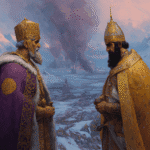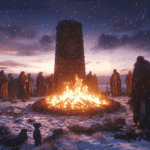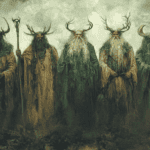
In the shadowed corridors of ancient Rome, beneath the bustling streets and within the hearts of soldiers and statesmen, flourished a secretive and enigmatic cult: Mithraism. Known as the Mithraic Mysteries or the Cult of Mithras, this religion captivated the Roman Empire, especially its legions, leaving behind a legacy of subterranean temples, cryptic iconography, and unanswered questions.
Persian Roots and Roman Adaptation
The origins of Mithraism stretch back to the ancient Persian worship of Mithra, a deity associated with the sun, justice, and contracts. In pre-Zoroastrian Iran, Mithra was revered as a guardian of truth and the cosmic order. Over centuries, the figure of Mithra evolved, becoming intertwined with Zoroastrian theology, where he was honored as a powerful yazata, or divine being.
As Persian culture encountered the Greek world and, later, the Roman Empire, the worship of Mithra underwent significant transformation. By the first century CE, the Romanized version of Mithraism had emerged, bearing only a distant resemblance to its Persian antecedents. The Roman Mithras was depicted as a youthful, cap-wearing god, often shown in the act of slaying a bull – a scene known as the tauroctony, which would become the central icon of the cult.
Spread Across the Roman Empire
Mithraism found fertile ground in the cosmopolitan and militarized society of the Roman Empire. The earliest evidence of the cult in the Roman world dates to the first century BCE, with references to Cilician pirates practicing secret rites dedicated to Mithras. By the end of the first century AD, Mithraic temples, or mithraea, were being constructed across the empire, from Roman Britain and Gaul to North Africa and the eastern provinces. The cult was centered in Rome.
The religion’s appeal was particularly strong among soldiers, merchants, and bureaucrats – those who traveled the empire’s vast networks and sought a sense of fraternity and spiritual discipline. Women, however, were excluded from the cult, which remained an exclusively male domain.

Beliefs and Cosmology
1. The Cosmic Battle and the Tauroctony
At the heart of Mithraic belief was a mythic narrative centered on the cosmic struggle between good and evil, light and darkness. The most iconic representation of this narrative is the tauroctony: Mithras, wearing a Phrygian cap, plunges a dagger into the neck of a sacred bull. Surrounding him are various animals – the dog, snake, and scorpion – each with symbolic significance.

The bull’s slaying was interpreted as a creative act, its blood bringing fertility and life to the world. This act was seen as a cosmic battle, with Mithras embodying the conquering force of light over darkness. Sunlight, in Mithraism, symbolized divine strength, spiritual rebirth, and the triumph of good.
2. The Role of the Sun and Other Deities
Mithras was closely associated with the sun god, Sol Invictus, or the Unconquered Sun. Many depictions show Mithras and Sol sharing a banquet, symbolizing their alliance in the cosmic order. The sun’s cycles were believed to influence human destiny, and by aligning themselves with these celestial forces, initiates hoped to achieve harmony and spiritual illumination.
Other figures, such as Cautes and Cautopates (torchbearers), appeared in Mithraic iconography, representing the dualities of day and night, life and death. The cult’s cosmology was rich and symbolic, reflecting a worldview in which the cosmos was a battleground for spiritual forces.
3. Afterlife and Moral Teachings
Mithraists believed in a celestial heaven and an infernal hell, with the soul’s fate determined by moral conduct and initiation into the mysteries. The cult emphasized virtues such as loyalty, courage, and truthfulness – qualities that resonated with the Roman military ethos. Initiation was seen as a spiritual rebirth, offering the promise of salvation and eternal life for the worthy.
Rituals and Practices
1. Seven Grades of Initiation
Mithraism was structured around a complex hierarchy of initiation, with seven grades that initiates could ascend through ritual and discipline. Each grade was associated with a planetary deity and had its own symbols, tests, and responsibilities. The grades were:
- Corax (Raven)
- Nymphus (Bridegroom)
- Miles (Soldier)
- Leo (Lion)
- Perses (Persian)
- Heliodromus (Sun Runner)
- Pater (Father)
Advancement through these grades was not merely ceremonial but involved rigorous training, secret knowledge, and moral development. The highest grade, Pater, was reserved for the spiritual leaders of the community.
2. Sacred Meals and Ritual Banquets
Central to Mithraic worship was the communal meal, often involving bread and wine, which echoed the mythical banquet between Mithras and the sun god. These meals were held in the mithraea, where initiates would recline on benches along the walls, sharing food and drink in a ritualized setting.
The act of sharing a meal symbolized unity, brotherhood, and the sanctity of the covenant – a theme inherited from Mithra’s role as a god of contracts in Persian tradition. The meal also served as a reenactment of the cosmic feast, reinforcing the initiate’s connection to the divine order.

The Mithraeum: Temples of Mystery
Mithraic worship took place in underground temples called mithraea, designed to resemble caves. This setting was symbolic, recalling the cave where Mithras was said to have slain the bull and evoking the primordial darkness from which light emerges.
A typical mithraeum featured:
- An altar at one end, often with a relief of the tauroctony
- Bench seating along the walls for initiates
- Frescoes and sculptures depicting scenes from the Mithraic mythos
- A small, intimate space, emphasizing secrecy and exclusivity
These sanctuaries provided a refuge from the outside world, a place where initiates could engage in ritual, contemplation, and fellowship.
Ritual Reenactments and Symbolic Acts
Mithraic rituals often involved reenactments of the mythic narrative – Mithras’s birth from a rock, the striking of water from stone, the slaying of the bull, and the ascent to heaven. Senior officers in the cult, such as the Pater and Heliodromus, played key roles in these ceremonies, guiding initiates through the mysteries and imparting secret teachings.
The rituals were designed to foster a sense of transformation, spiritual ascent, and participation in the cosmic drama. The absence of female personages in the narrative, apart from rare exceptions, reinforced the cult’s masculine ethos.
Brotherhood and Fraternity
Mithraism fostered a strong sense of brotherhood among its members, who referred to themselves as syndexioi, or “those united by the handshake”. The cult’s exclusivity and secret rites created a tight-knit community, bound by shared experiences and mutual trust.
This sense of fraternity was particularly appealing to soldiers, who found in Mithraism a spiritual counterpart to the camaraderie of military life. The cult’s hierarchical structure, with its grades and ranks, mirrored the organization of the Roman army, further enhancing its appeal among the martial classes.
Recent scholarship has emphasized the local character of Mithraic communities. Rather than a centralized, uniform religion, Mithraism consisted of numerous small groups, each led by a pater who shaped the cult’s practices according to local traditions and needs. This diversity allowed Mithraism to adapt to different regions and social contexts, contributing to its widespread popularity.

Rivalry and Competition with Christianity
Mithraism and Christianity emerged as rival religions in the Roman Empire, both offering salvation, moral guidance, and the promise of eternal life. The two faiths shared certain features: rituals, initiation, communal meals, and an emphasis on moral conduct.
Some scholars have speculated about possible influences between the two religions, noting similarities in iconography and ritual. However, most agree that these parallels reflect broader cultural currents rather than direct borrowing.
Decline and Suppression
The fortunes of Mithraism began to wane in the fourth century, as Christianity gained imperial favor and eventually became the state religion of the Roman Empire. The Edict of Milan in 313 AD marked a turning point, as Christian tolerance gave way to dominance.
Mithraic temples were closed or destroyed, and its followers faced persecution. The decline was not solely due to external pressure; changes in society, the loss of charismatic leaders, and the shifting spiritual landscape all contributed to the cult’s demise. By the end of the fourth century, Mithraism had all but disappeared from the Roman world.
Archaeological Legacy
Despite the absence of written scriptures or theological treatises, Mithraism has left a rich archaeological legacy. More than 400 mithraea have been identified across the former Roman Empire, along with thousands of inscriptions, reliefs, and artifacts.
The most common motif is the tauroctony, found in nearly every mithraeum. Other artifacts include altars, statues, and ritual vessels, offering glimpses into the cult’s practices and beliefs. The distribution of these finds attests to the widespread appeal of Mithraism, from the frontiers of Britain to the deserts of North Africa.
Conclusion
Mithraism stands as one of antiquity’s most intriguing and enigmatic religions. Its secretive rites, powerful imagery, and appeal to the Roman military and elite made it a formidable spiritual force during its heyday. Yet, like so many ancient mysteries, it ultimately succumbed to the changing currents of history, leaving behind only fragments for modern scholars to piece together.
The story of Mithraism is a testament to the complexity of religious life in the ancient world and the enduring human quest for meaning, transformation, and connection to the divine. In the darkness of the mithraea, initiates sought the light of spiritual truth – a light that, though dimmed by time, continues to fascinate and inspire.




